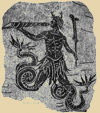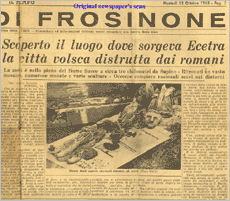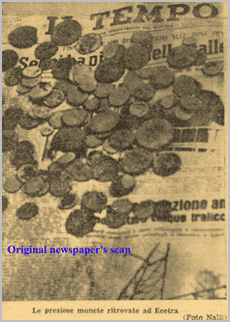IL TEMPO DI FROSINONE
October 15th, 1963 The region is in the
plains of the Sacco River approximately three kilometres from Supino. Found was
a large mosaic, numerous coins and various sculptures.
It is essential to
do more excavations in the area.

With the discovery of a mosaic of exceptional and artistic value, little doubt
remains now in Supino that Ecetra, an ancient and heroic city, razed to the ground
by the Romans for punishment, rose from the vast basin of the Sacco River, in
the Privito area, approximately three kilometres from the centre of town. Two
young amateur archeologists discovered this large mosaic yesterday. Although excavations
have just begun, the site currently measures two metres by two metres. This discovery
adds to the infinite number of other precious ruins, small statues, amphorae and
various other objects already found in the nearby ancient graveyard at Privito.
 Amazingly
the mosaic was found unusually close to the surface not more than 30 or 40 centimetres
deep. Already hundreds of curious people have come to the Cona del Popolo area
to see the discovery. The terrain, in the immediate area of the mosaic was a meadow
that was never worked. Many years ago, a farmer had tried to dig into the earth
but easily gave up as he found it impossible to do. So the land laid undisturbed
until now. Amazingly
the mosaic was found unusually close to the surface not more than 30 or 40 centimetres
deep. Already hundreds of curious people have come to the Cona del Popolo area
to see the discovery. The terrain, in the immediate area of the mosaic was a meadow
that was never worked. Many years ago, a farmer had tried to dig into the earth
but easily gave up as he found it impossible to do. So the land laid undisturbed
until now.
During the pre-war period, there were several farmers in the
surrounding countryside of Supino that had unearthed many artistic amphorae and
other ancient artifacts while farming their land. The farmers hastened to make
these artifacts disappear for fear of further searches and seizures of the land
by the government. Among the artifacts found were coins, lots of them,
a little bit everywhere and of a variety of different ages: from as early as the
fourth century B.C. to the late Roman Empire. The first suspicions that
these various findings were the ruins of Ecetra, began to arise when the parish
priest of Saint Mary, Father Egidio Schietroma, compared the ancient coins with
the ones reproduced at the Institute of the History of the Arts. He realized that
the copper and other alloy coins were similar to those of incomparable Etruscan
art. It is now known that the Volsci people once lived in the surrounding area
even before the establishment of Rome, and the Volsci had multiple contacts, not
only commercial, but social as well with the Etruscans assimilating the Etruscan
culture into their own. To this day little has remained unchanged as a result
of this assimilation.
 As
a result of the discovery of the mosaic's, a missing small bronze statue that
was found by a local townsperson years earlier reappeared and was sent to a variety
of ancient art scholars to get an opinion of its possible origin. As
a result of the discovery of the mosaic's, a missing small bronze statue that
was found by a local townsperson years earlier reappeared and was sent to a variety
of ancient art scholars to get an opinion of its possible origin.
Doctor
Belloni, curator of the Museum of Arts of the Sforza's Castle of Milan, affirmed
that, without any doubt, the bronze statuette must date back to the eras between
the third and fourth century and that is was the work of local artisans.
These various ancient findings, which are now preserved at the local police
station or in the parish church of Saint Mary, aroused the curiosity of two young
men, Roberto D'Arolfi, a nineteen year old student in his fifth year of accountancy
in Anagni and Ernesto Carbonelli, a twenty-five year old electrician from Colleferro
(originally from Supino). The two of them, one Sunday morning, armed with a pike
and a shovel, began to dig in the meadow that belonged to the parish church of
Saint Benedict, taken care of by a local, Cataldo Corsi, near some old ruins.
What these two young men found proved their suspicions right. In the shadow of
two very old oak trees, came forth a mosaic depicting the god Neptune armed with
his trident guiding a foursome of aquatic horses. The mosaic, black on white,
is so well defined that it leaves you speechless.
The two young men realized
that what they had discovered was more than they could have imagined, they halted
the excavations and hurried to alert the carabinieri. Now we are waiting for the
curators of the Belle Arte to continue the excavations with the necessary precautions
to unearth the mosaic in it's entirety and in its' original state. It has
been suggested, that in this area where the mosaic was found once existed a temple
of an ancient god with an offering fountain nearby. The remains of a nearby ancient
aqueduct and the discovery of the coins from all the different eras also support's
the possible existence of an ancient temple. Father Egidio Schietroma, who has
completed many insightful studies on the area, is sure that in the era following
the destruction of the city of Ecetra, Romans nobles had constructed their villas
on the ruins of the Volsci strong holds.
From here has derived the necessity
to excavate more extensively not only to unveil the remains of these ancient ruins,
but also, most importantly, to ascertain that this may actually be the ancient
remains of the city of Ecetra. Which supports the testimony of the historian Tito
Livio that the city of Ecetra was in the vicinity of Ferentino. Naturally, the
decision is now up to the municipal administration of Supino to continue the necessary
excavation of the site. By continuing the excavation, hopefully it can be confirmed
that this is the site of the remains of the ancient city of Ecetra, and can be
declared a national tourist attraction. At the very least to obtain government
finances for the construction of a small museum to conserve the ancient relics
that have been found up until now. In both ways, the discovery of this ancient
mosaic will benefit this small Ciociaro center.
| |











